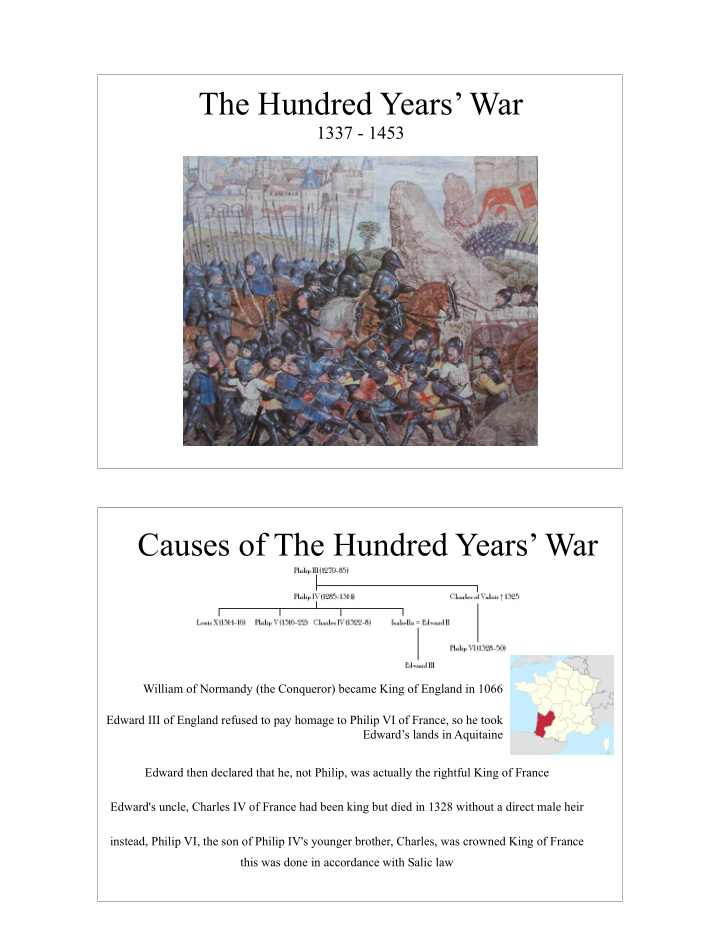



The Hundred Years’ War 1337 - 1453 Causes of The Hundred Years’ War William of Normandy (the Conqueror) became King of England in 1066 � � � Edward III of England refused to pay homage to Philip VI of France, so he took Edward’s lands in Aquitaine Edward then declared that he, not Philip, was actually the rightful King of France � � � Edward's uncle, Charles IV of France had been king but died in 1328 without a direct male heir � � � instead, Philip VI, the son of Philip IV's younger brother, Charles, was crowned King of France � this was done in accordance with Salic law
War Erupts The Hundred Years’ War was a series of short raids and a few major battles � In almost every engagement, the English were outnumbered. � At one point, the French army had over 50,000 compared to Britain’s 32,000 The best English defensive position was made through the use of the longbow. � � Its arrows had more penetrating power than a bolt from a crossbow (what the French used). The Battle of Crécy (1346) Edward III landed in Normandy in July 1346 with about 10,000 men. � The English used their longbowmen to check each French attack. � At the end, the French were decimated and the English had a decisive victory. The Battle of Poitiers (1356) A disastrous battle for France � the English capture King (Jean II) and 2,000 French aristocrats � The English demand an enormous ransom � France is paralyzed without a king
Battle of Agincourt (1415) England’s Henry V attacked 20,000 French soldiers with a force of 6000 Englishmen. � The first two lines of French knights were unsuccessful in their charge. The third line moved to engage but lost heart when they crossed the field covered with French dead. � Henry V was left with control of the battlefield and a decisive victory. Jeanne d’Arc (Joan of Arc) (1412-1431) young French peasant girl � wore her hair short and dressed like a man heard voices that told her to go to the king to assist him in driving out the English � � brought inspiration, self-confidence, and a sense of national identity to the French captured during an attack on Paris and sold to England � was condemned by the English and burned as a heretic in 1432 � became one of two patron saints of France
Battle of Orléans (1428-1429) the French city of Orleans had been under seige from the English for months � Joan of Arc entered the city with a small force � brought needed supplies and troops in � rallied the population the English retreated The Hundred Years’ War Ends in 1453 the French armies captured an English-held fortress in Castillion � there was no official treaty, only a cessation of hostilities Effects of the War � France France = national identity � England England = devastated � led to the Wars of the Roses between the houses of York and and Lancaster
The House of York The York faction was led by Richard, The White Rose of York Duke of York, and his son Edward. When Richard died in 1460, his son Edward became the leader of the York forces. He was tall, handsome, and a lover of wine, women, and pleasure. The House of Lancaster The Lancaster faction was led by The Red Rose of Lancaster Queen Margaret of Anjou she was the wife of King of England, Henry VI
In 1464 Edward secretly married The marriage infuriated Elizabeth Woodville Richard Neville, Earl of Warwick. In alliance with Margaret of Anjou, Warwick forced Edward to flee England. Henry VI’s “re-adoption” as King did not last long. Edward quickly raised a large army in the Netherlands and defeated and killed the Earl of Warwick. � Edward ruled England without challenge from 1471 to his death in 1483. Upon Edward’s death, his brother Richard was named Lord Protector of the realm for Edward's son and successor, the 12-year- old King Edward V. � Before the young king could be crowned, however, his father's marriage to his mother Elizabeth Woodville was declared invalid, making their children illegitimate and ineligible for the throne. � Richard III then began his reign. The young princes were not seen in public after August, and a number of accusations circulated that the boys had been murdered on Richard's orders.
The new leader of the Lancastrian forces was Henry Tudor. Battle of Bosworth Field 1485 King Richard III The Yorkist army v. melted away, Henry Tudor while Richard was killed Richard was slain during the battle by with a blow to the head from major Welsh landowner Rhys ap Thomas
Henry Tudor (Henry VII) claimed the throne. The House of Tudor subsequently ruled England and Wales until 1603 Henry Tudor The Tudor Rose combined the Red Rose of Lancaster and the White Rose of York.
Recommend
More recommend